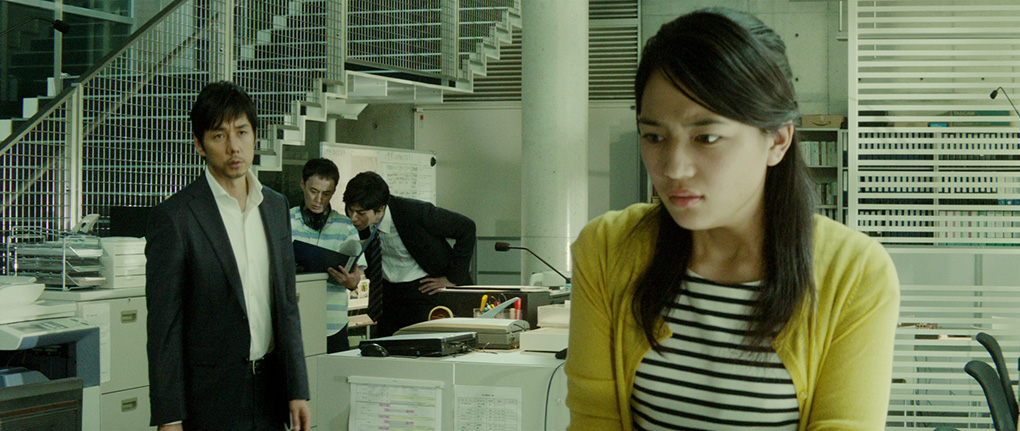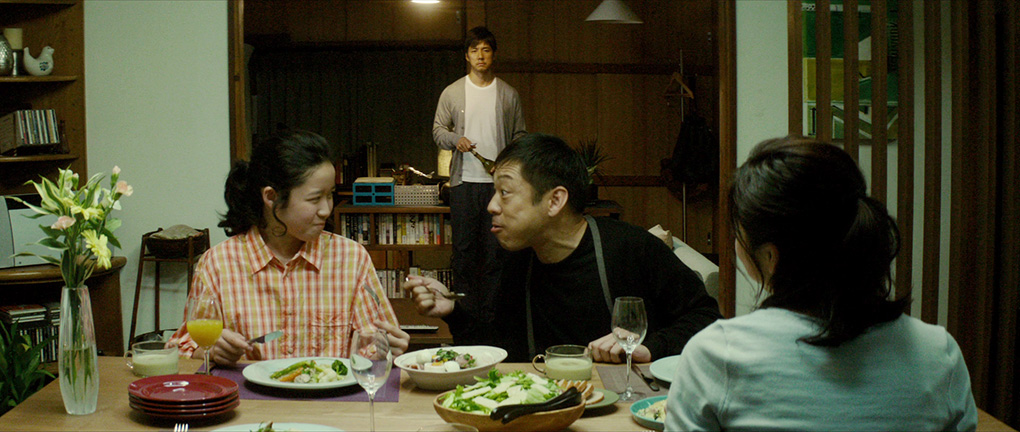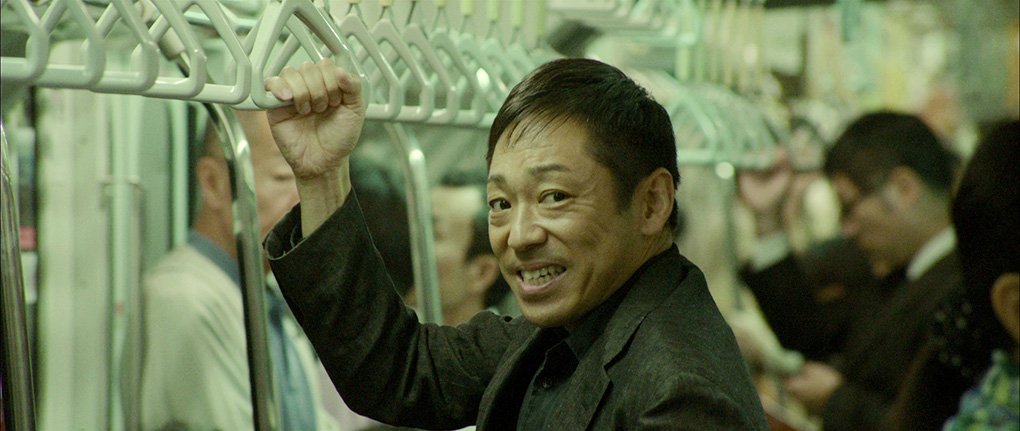|
There's a moment during the arresting opening sequence of Creepy [Kurîpî: Itsuwari no rinjin], the latest film from Cure, Pulse and Tokyo Sonata director Kurosawa Kiyoshi, that seems to suggest that are watching a supernatural thriller. Police psychologist Takakura (Nishijima Hidetoshi) is talking to younger detective Nogami (Higashide Masahiro) outside a room in which Matsuoka – a man whom Takakura believes is 'the perfect psychopath' and worthy of further study – is being held. As the two men converse, the door to the room slowly swings open behind them, and when they rush through it there is no sign of Matsuoka, while the policeman who was guarding him is unconscious on the floor. But here's the thing – although we saw the door swing open, at no point did we see Matsuoka leave the room through it. It's almost as if he had thrown on a cloak of invisibility. Is he, perhaps, a malevolent spirit in human form? A short while later we're presented with evidence to the contrary when he's cornered after taking a hostage by wedging a fork in her neck. As Takakura steps forward to convince him to surrender using phrases straight out of the hostage negotiation manual, Matsuoka stabs him in the back and slashes the hostage's throat, then is promptly shot dead by a small army of Takakura's colleagues.

Some months later, Takakura has physically recovered from his injury, but has retired from the force and taken up a university teaching post in the suburban area to which he and his wife Yasuko (Takeuchi Yûko) have quietly relocated. Initial impressions suggest they have not moved to the most welcoming of streets – a woman who lives two doors down dislikes talking to others, whilst their immediate neighbour Nishino (a wonderfully unsettling performance from Tokyo Sonata's Kagawa Teruyuki), is a socially awkward oddball whose manner can switch from quietly suspicious to over-enthusiastically friendly in the course of a few seconds, something that initially gives Yasuko the creeps. Takakura, meanwhile, although seemingly determined to put his past behind him, continues to draw on his previous police work for criminology lectures, and a chance conversation with his colleague Okawa piques his interest in an unsolved case in which a couple and their son disappeared without trace. Unsure why this was categorised as a crime at all, Takakura agrees to accompany the enthusiastic Okawa to the house in which the family lived, and while he declines to venture inside the building itself, something about the location clearly disturbs him – "It feels like a crime scene," he later remarks. A short while later he is tracked down by Nogami, who has also developed an interest in the case, and while initially reluctant to become more deeply involved, Takakura soon finds himself working with his former colleague on an unofficial investigation into the family's disappearance.
All of this is handled in a grippingly matter-of-fact manner, as the pull of a mystery whose exact nature is unclear does low-key battle with Takakura's reluctance to revisit the demons of his past. By comparison, Takakura's neighbour Nishino's unpredictable and sometimes troubling behaviour towards Yasuko can seem a little too on the nose, inviting us to see him as a potential threat some time before Takakura – a former criminal psychologist with a specific interest in psychopathic behaviour – seems prepared to do likewise. But as the story unfolds it becomes clear that there will be no moment of sudden revelation about Nishino's true nature and that tipping the audience off from at an early stage is a key component of the serious wind-up that Kurosawa unleashes in the film's second half. By the time Takakura is convinced of the threat that Nishino represents, the audience is with him and thus gets to share his frustration at the blocks that are put in his way, and fear for what Nishino's insidious new friendship with Yasuko might be building up to.

It struck me from the moment that I first heard about the film that Creepy is a somewhat presumptuous title, one that not only hints at the content but also suggests how the audience should respond to it. That's a subjective call at best whatever the film in question, a bit like calling a horror film 'Scary', a chase thriller 'Exciting' or a romantic comedy 'Heart-Warming'. And this is not due to suspect English translation – Kurîpî (the closest you can get to the English pronunciation in the syllable-structured Japanese language) is the original Japanese title* – which can't help but link it to Kurosawa's 1997 breakout film Cure [Kyua], a somewhat less proclamatory English language title for a work to which Creepy sometimes feels organically bonded.
Just as it was in Cure, there are no startling plot twists or sudden bursts of high-octane action, the emphasis instead being placed on mood and a seriously discomforting air of steadily mounting dread. In keeping with this approach, Kurosawa's direction remains resolutely low-key throughout, favouring static and slowly drifting camera shots over the hand-held waggle-cam of many modern police thrillers. This is at its most unsettlingly mesmerising when Takakura and Nogami are questioning the missing family's daughter Saki about events leading up to their disappearance, and all three move around the room in what plays almost like a slow dance of gradual recollection and discovery. It's something Kurosawa's regular cinematographer Ashizawa Akiko's drifting camera becomes part of and enhances, as characters are pulled away from the comforting light of a window seat into blanketing pools of ominous shadow. The soundtrack is similarly stripped of overstatement, particularly in the use of low-level bass rumbles to expressionistically underscore the underlying menace of otherwise innocuous or unthreatening scenes.

Creepy is a film that crawled under my skin in the manner of some of the more troubling Korean serial killer thrillers of recent years, a comparison I do not make lightly or without specific reason. There are scenes in its second half that are genuinely unnerving and uncomfortable to watch, and by withholding the specifics of the antagonist's psychological and chemical hold on those he targets, and by subtly linking his activities to those of a more notorious real-world monster, Kurosawa makes it all discomfortingly easy to swallow and gently pushes us to be as disturbed by the implications of what is unfolding as we are by what we see. It may not have Cure's allegorical depth or – despite the suggestive nature of that opening sequence – its unsettling paranormal overtones, but Creepy still sees Kurosawa back on home turf, and he delivers here his most unsettling and darkly compelling film for some while, one that lives up to and frankly surpasses the promise of its title.
Shot digitally on the Arri Alexa XT Plus, the 2.35:1 transfer on the Blu-ray in this dual format release is first-rate, from the crispness of its detail to the strong but never over-saturated colour. It also copes well with Kurosawa's use of shadow and pools of darkness and sometimes extreme differences between the two in the same shot. Sourced as it was from a digital master, there is no damage or dust to contend with, and I could see no evidence of (given the camera and the medium, completely unnecessary) DNR or edge enhancement.
There's a choice of soundtracks between Linear PCM 2.0 stereo and DTS-HD Master Audio 5.1 surround, both in the original Japanese. Sonically similar in many respects – both are crystal clear, with a strong dynamic range and clear stereo separation – there is slightly more bass to the underscore rumbles on the DTS track, and as ever the dialogue sits front and centre on the 5.1 but is spread evenly across the front speakers on the stereo.
The optional English subtitles are always clear, whatever the background brightness.
Light in a Dark Corner – Interview with director Kurosawa Kiyoshi (37:46)
A visually unflattering but consistently interesting interview with writer-director Kurosawa, in which he answers questions on whether Creepy marks a return to the dark style of his earlier work, his work with actors and cinematographer Ashizawa Akiko, the film's few moments of offbeat humour, the vibrant use of specific colours, learning from Hitchcock and a good deal more. I was intrigued to learn that he enjoys attending film festivals because they offer a chance for Japanese directors to meet and socialise with one another, something that apparently rarely happens on home turf, and that while he'd like to shoot a film in America, the experience of colleagues who've done so has convinced him that he wouldn't be happy working in Hollywood.

Theatrical Trailer (1:32)
A well enough constructed Japanese trailer that is peppered with spoilers and suggests the film is faster paced than it is, but does end with a delicious pronunciation of the work "Creepy" and the warning that we should "Beware of the creep next door."
Booklet
The meat of this booklet is a solid essay on the film and its director by Jasper Sharp, which is accompanied by credits for the film, stills and the usual advice on how to set up your TV. You know this by now, surely?
Creepy was one of the few films I managed to catch at last year's London Film Festival before being whipped off to hospital, and given the subject matter and the director's track record, it was one of the screenings that I was most looking forward to. It didn't disappoint, and watching it again three months later, fully aware of how the story plays out, I still became thoroughly engrossed in the story and suitably chilled by the later turns it takes. The package is a little light on extra features (the on-disc double gives it the feel of an Artificial Eye release), but the interview is useful, the booklet essay good, and for the film and the transfer, this still comes strongly recommended.
* The full Japanese title is apparently Kurîpî: Itsuwari no rinjin, and from what I can gather, ‘Itsuwari no rinjin’ would describe a neighbour who is not what he claims to be, literally “falsehood neighbour". It should be noted, however that the title on this print of the film is a solitary Creepy, which appears almost simultaneously in Japanese katakana and English.
This review is an expanded version of London Film Festival one posted last year.
The Japanese convention of surname first has been used for Japanese names throughout this rveiew.
|